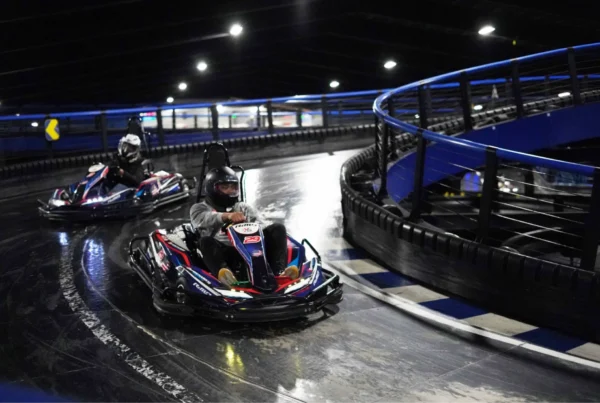Understanding Gamification in Entertainment
Gamification refers to the integration of game design elements in non-game contexts, aiming to enhance user engagement and drive participation. In the entertainment sector, this concept has gained considerable traction, transforming traditional recreational activities into dynamic experiences that attract and retain audiences. By adding layers of interactivity, competition, and rewards, gamified attractions not only appeal to individual participants but also foster social interactions among them, creating a vibrant community atmosphere.
Examples of gamification in entertainment are abundant, ranging from theme parks that incorporate interactive ride experiences to mobile applications that enhance engagement with television shows and movies. For instance, some amusement parks have developed rides that utilize augmented reality, allowing riders to earn points or compete against others as they navigate thrilling scenarios. Similarly, television networks have launched companion apps that encourage viewers to participate in live polls or quizzes, rewarding them with points or prizes for their engagement. Such initiatives illustrate how gamified attractions can significantly elevate user experience and satisfaction.
Psychologically, gamification resonates with consumers due to its ability to tap into fundamental human desires. Elements such as competition stimulate a drive to excel and outperform others, while the prospect of earning rewards serves as a powerful incentive. Furthermore, the social aspect of many gamified experiences encourages connections among participants, reinforcing the importance of community and shared experiences in entertainment. As individuals pursue achievements within these gamified frameworks, they undergo a more immersive experience, engaging not only with the content but also with one another.
As the entertainment industry continues to evolve, understanding the principles of gamification will be crucial in creating engaging experiences that attract new audiences and retain existing ones.
Examples of Gamified Attractions
Gamification has permeated various sectors of entertainment, leading to innovative attractions that enhance engagement and interactivity. One prominent example can be found in theme parks, where attractions such as the “Buzz Lightyear Astro Blasters” at Disneyland incorporate gamification by allowing guests to compete against each other. Visitors use laser guns to score points by hitting targets, integrating an element of competition into the ride. This not only heightens visitor engagement but also adds replay value, as guests often return to improve their scores.
Another notable instance is the rise of escape rooms, which utilize gamified elements to create thrilling experiences. These attractions require participants to solve puzzles and complete tasks within a set time frame, thereby encouraging teamwork and problem-solving skills. Facilities such as “Escape the Room” have successfully implemented these gamified mechanics, resulting in high visitor satisfaction rates, increased repeat business, and positive word-of-mouth recommendations. The social interaction and shared triumphs promote a memorable experience that resonates with players long after they leave the room.
Virtual reality (VR) experiences also exemplify gamification in entertainment. Attractions such as “The Walking Dead: A Live Experience” offer immersive environments where participants can interact with their surroundings to survive zombie encounters. This form of entertainment effectively utilizes gamified mechanics, allowing guests to influence the outcome of their experience through active participation. Studies have shown that such immersive attractions lead to heightened emotional investment and a significant boost in visitor enjoyment, contributing to the retention and loyalty of patrons.
Overall, these examples illustrate how incorporating gamification principles into attractions fosters deeper engagement among guests, leading to improved satisfaction and business success. With the continuous evolution of entertainment technologies, the potential for gamified experiences appears boundless.
The Technological Evolution Behind Gamification
The technological landscape has significantly evolved over the past few years, facilitating the rise of gamification in entertainment. Divergent innovations, particularly in augmented reality (AR), mobile applications, and data analytics, have played pivotal roles in enhancing user engagement within gamified attractions. AR technology, for instance, overlays digital elements onto the real world, creating immersive experiences that captivate audiences. This seamless integration allows for interactive storytelling and enhanced social interactivity, encouraging visitors to participate actively rather than being mere spectators.
Mobile applications further bolster gamification by providing a platform for users to track their progress, compete against friends, and access exclusive content. These apps often utilize geolocation features to encourage exploration, rewarding users for participation and engagement. As individuals increasingly rely on smartphones and tablets, the effectiveness of gamified experiences is amplified, allowing for a more personalized and flexible engagement model that meets varied user preferences.
Additionally, the advent of data analytics has transformed the manner in which user experiences are crafted in gamified environments. By analyzing user behavior patterns, preferences, and engagement levels, creators can tailor attractions to maximize satisfaction and retention. This data-driven approach not only enhances the gamified experience but also fosters a deeper connection between users and the attractions themselves.
Looking towards the future, the integration of artificial intelligence (AI) and machine learning into gamification practices is poised to revolutionize the industry further. These technologies have the potential to refine user interactions in real time, adapting experiences based on individual preferences and behaviors. As tech advancements continue to unfold, engaging audiences through gamified attractions will only evolve, shaping new ways for entertainment to connect with users in the coming decade.
The Future Landscape of Entertainment Through Gamification
The realm of entertainment is poised for significant transformation as gamification continues to shape consumer expectations. With the rise of interactive experiences, businesses are compelled to adapt their strategies to meet the evolving demands of their audiences. Gamification integrates elements of game design into non-game contexts, enhancing user engagement by making experiences more enjoyable and participatory. As entertainment evolves, we can anticipate a greater emphasis on personalization, where consumers are not just passive observers but active participants.
One of the notable trends in gamification is the emergence of user-generated content, which empowers participants to contribute their narratives and experiences. This approach fosters a sense of ownership and community, making the entertainment landscape more dynamic and inclusive. As users engage with different platforms, their contributions can significantly influence the direction of future offerings, creating a feedback loop that informs businesses about audience preferences and expectations. The power of social competition also plays a critical role; as audiences increasingly seek social interaction, compelling gamified elements can facilitate connections between users, enhancing shared experiences that enrich entertainment consumption.
Moreover, a deeper understanding of gamification’s potential can lead to innovative entertainment forms designed to attract diverse demographics. By tapping into various age groups, cultural backgrounds, and interests, businesses can create experiences that resonate with wider audiences. For instance, incorporating elements of storytelling and challenge within gamified environments can foster engagement across multiple platforms, breaking down barriers between social media, gaming, and traditional entertainment.
As we look towards the future, the implications of these trends suggest that gamification will not only redefine how entertainment is consumed but will also enhance marketing strategies. By leveraging the defining characteristics of gamified experiences, businesses are better positioned to create compelling narratives and memorable interactions that foster long-lasting consumer loyalty. Overall, understanding the importance of gamification will be essential for shaping the next generation of entertainment.








